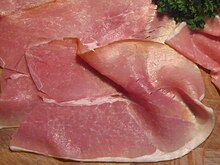Holstein ham

Holsteiner ham is a north German ham specialty from the Schleswig-Holstein region of Holstein . Production is salted ham meat (ham from pigs ) in Kate smoke up to eight weeks smoked . Holstein ham manufacturers have joined the Schleswig-Holstein ham manufacturer protection association. V. organized to apply to the EU for a protected geographical identification, which was granted in 2012. Holsteiner Katenschinken was first mentioned in writing around the year 1600. Holsteiner Katenschinken consists of the sections: upper shell , lower shell , nut (flower) and hip (cap).
Traditionally, ham was smoked over the open fireplace. With the introduction of closed fireplaces with smoke extraction , the smoking process shifted to special smoking chambers or to barns or hallways in which the smoking material was burned. In northern Germany, cottages are small village houses that were lived in and worked by part-time farmers in the past . Some of these houses were mainly used for smoking and have been called Räucherkate ever since .
"Holsteiner Katenschinken" has been a protected geographical indication ( PGI ) of the European Union since January 2012 .
Manufacturing
Criteria for the selection of raw materials and ingredients
- The pH value of the raw ham must not exceed 5.8, otherwise the meat cannot lose enough water.
- Firm meat of the raw ham ( PSE meat is unsuitable)
- Meat from the leg, lower shell, upper shell, ball, hip (connected)
Spices
- salt
- Coarsely ground natural spices
- sugar
Manufacturing scheme
The club is first released with a knife , but without removing the bones including the shank. The leg is rubbed with salt and spices once a week for a period of six to eight weeks ( dry curing ). The ham then rests for about three weeks during the so-called burning time.
Smoking in katen smoke is a cold smoking process. There are various details about the smoking temperatures in the production of Holstein ham (e.g. alternations between 8 ° C and 26 ° C, or constant at 20 ° C). Juniper bushes and other hardwood can serve as smoking material. Additional herbs such as heather or juniper berries can also be added. However, traditionally beech wood or oak wood is used as the smoking material for Holsteiner Katenschinken. However, conifers are never used because they cause a resinous taste.
The after-ripening after the smoke is traditionally done in the ham canopy of a barn or hall. The ripening period lasts up to six months, depending on the time of year. Nowadays, vacuum methods are also used in modern buildings to accelerate the ripening process.
taste
The aroma of katen-smoked meat products is strong and piquant, but very fine. The Kat ham has a mahogany-colored appearance, it should not be black-brown sooty. Holstein ham in particular is not smoked too intensely, so that a mild taste and a delicate consistency are achieved.
use

The original Holsteiner ham is like on bread for because of its mild, slightly tangy flavor ham sandwich , sandwiches (canapés), sandwiches and finished rolls as well as cold cuts plates (Holsteiner ham plate / paper plates) used. It is also suitable for dishes such as Strammen Max and as a cold meat accompaniment to jacket potatoes or boiled potatoes and to many vegetable preparations , especially asparagus . As a meat side dish, Holsteiner Katenschinken is used in thicker slices than with bread, especially in Northern Germany . As a result of the decline in butcher shops and service counters in supermarkets , in addition to packaged ham slices, some thick slices of ham are now also being offered as self-service goods, especially during the asparagus season.
Web links
- Holsteiner Katenschinken - Information website of the Schleswig-Holstein Chamber of Agriculture
- Holsteiner Katenschinken (PGI) - Information on the website Quality mark of the Schleswig-Holstein Chamber of Agriculture
Individual evidence
- ↑ www.gzsh.de/produkte/fleisch/holsteiner-katenschinken/
- ↑ www.schleswig-holstein.de/UmweltLandwirtschaft/DE/LebensmittelTierGesundheit/01__Lebensmittel/IsstLecker/Fleisch/isst__lecker__Katenschinken.html ( page no longer available , search in web archives ) Info: The link was automatically marked as defective. Please check the link according to the instructions and then remove this notice.
- ↑ www.holsteinerkatenschinken.de/index.php?link=tradition ( page no longer available , search in web archives ) Info: The link was automatically marked as defective. Please check the link according to the instructions and then remove this notice.
- ↑ Inclusion of the “Holsteiner Katenschinkens” in the EU quality register . At: legal information system juris from January 31, 2012; Retrieved March 4, 2012.
- ↑ Holsteiner Katenschinken (PGI) . Quality mark of the Schleswig-Holstein Chamber of Agriculture on the website ; Retrieved March 4, 2012.
- ↑ a b www.steffen-muxall.de/schinken.html ( Memento of the original dated May 11, 2009 in the Internet Archive ) Info: The archive link was inserted automatically and has not yet been checked. Please check the original and archive link according to the instructions and then remove this notice.
- ↑ www.holsteinerkatenschinken.de/index.php?link=produktion2 ( page no longer available , search in web archives ) Info: The link was automatically marked as defective. Please check the link according to the instructions and then remove this notice.
